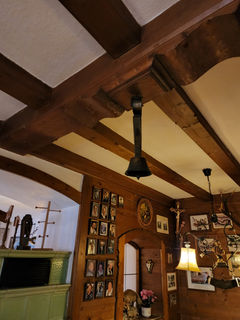
Hybrid Timber Framing: The Best of Both Worlds
Timber frames exude a timeless elegance, their beauty and craftsmanship elevating any home. But for many, the desire for exposed timber needs to find balance with the realities of a building project budget and design vision. Hybrid timber framing offers the perfect solution.
This approach allows you to optimize your investment in timber by strategically incorporating it where it has the most impact. Imagine entertaining in a grand living room adorned with a soaring timber truss overhead. Picture a cozy bedroom bathed in natural light, accented by a rustic timber beam ceiling. Hybrid framing gives you the power to integrate timber into the spaces that matter most to you, without sacrificing functionality in other areas of your home.
But hybrid timber framing isn't just about affordability – it's about design flexibility as well. Whether your style leans towards the rustic charm of exposed beams and rough-hewn posts, the clean lines of a modern minimalist aesthetic, or anything in between, hybrid timber framing delivers the versatility to make your timber dreams a stunning reality. Timber can be a statement piece in your entryway, adding warmth and grandeur as guests arrive. It can create a dramatic focal point in your kitchen, framing a hearth or breakfast nook. And throughout your home, strategically placed timber accents can add a touch of timeless character and natural beauty.

Understanding Traditional Timber Framing
Traditional timber framing is a centuries-old construction method celebrated for its strength, visual appeal, and enduring charm. These buildings are built with large, carefully joined timbers that form the building's entire structural skeleton. The exposed beams, intricate joinery, and natural wood warmth create a unique and stunning aesthetic.
However, traditional timber frames also come with a few potential drawbacks:
-
Cost: The specialized materials and labor-intensive craftsmanship of traditional timber frames can lead to higher construction costs.
-
Design Limitations: While beautiful, the structural requirements of a fully timber-framed home can sometimes limit design flexibility, particularly with modern and open floor plans.
This is where hybrid timber framing offers an elegant solution. By blending the beauty of traditional timber framing with the practicality of conventional framing techniques, hybrid approaches can address the potential cost, design, and maintenance considerations of a fully timber-framed structure.
The Advantages of Hybrid Timber Framing
Timber frames create a warmth and connection to nature that conventional construction cannot match. However, for many, the dream of a fully traditional timber frame can be tempered by budgetary realities and design aspirations that clash with how traditional timber frames are constructed.
This is where hybrid timber framing steps in, offering a brilliant solution that allows you to optimize your investment in timber. Here's how:
-
Strategic Timber Integration: Hybrid framing lets you focus the beauty and craftsmanship of timber on the areas where it will have the most impact. Crave a majestic living room with a dramatic, exposed timber truss overhead, but don't want any timbers in the bedrooms? Hybrid framing makes it possible. By strategically using timber in key areas, you maximize its visual appeal while keeping your project within budget.
-
Modern Meets Tradition: Hybrid framing isn't just about replicating traditional timber homes – it's about embracing design flexibility. Whether your vision leans towards the rustic charm of exposed beams or the clean lines of modern minimalism, hybrid framing allows you to seamlessly blend timber accents with contemporary design elements. Imagine a grand entryway where timber posts and beams create a sense of arrival, complementing a clean-lined, open-concept floor plan. Picture a gourmet kitchen featuring a timber-framed breakfast nook bathed in natural light, adding a touch of warmth next to sleek, state-of-the-art appliances. With hybrid framing, the possibilities are truly endless.
-
Investment-Conscious Optimization: In addition to being stylistically constricted, a fully traditional timber frame can be a significantly larger investment in comparison. Hybrid framing offers a cost-effective way to achieve the aesthetic you desire without breaking the bank. By strategically using timber in specific areas and leveraging conventional framing methods elsewhere, you optimize your material and labor costs, allowing you to invest more in the elements that matter most to you – high-end finishes, upgraded windows, or simply put it back in your wallet.
Hybrid timber framing is a clever design strategy that allows you to tailor your dream home to your unique style and financial goals. The next section will delve deeper into how hybrid framing differs from traditional timber framing, highlighting the key advantages that make it such a compelling choice for discerning homeowners.

Beyond the Traditional Timber Frame
The classic timber frame home evokes a sense of history and enduring craftsmanship. These architectural marvels, with their intricate joinery and exposed timbers, are testaments to a bygone era. But what if you crave a touch of that timeless elegance without being bound by the structural approach of a traditional build? Hybrid framing offers a compelling alternative, delivering several key advantages:
-
Structural Versatility: Traditional timber frames act as the primary structural support for the entire building. In contrast, hybrid framing utilizes a combination of approaches. Timber elements are strategically placed for visual impact and architectural interest, while conventional framing methods handle a significant portion of the structural load. This allows for a more flexible design and can be particularly advantageous for complex rooflines or expansive open floor plans.
-
Timber Efficiency: Traditional timber frames require a substantial amount of heavy timber throughout the entire structure. Hybrid framing takes a more targeted approach, focusing on incorporating timber elements where they have the most visual impact. This translates to a more efficient use of timber resources, potentially reducing material costs and environmental impact.
-
Unmatched Customization: Hybrid framing truly shines when it comes to customization. The level of timber integration, the style of the elements, and the overall aesthetic can be tailored to your specific preferences. Do you yearn for a rustic retreat with rough-hewn timbers that also performs with the efficiency of a modern home? Hybrid framing can deliver. Want the warmth of exposed rafters in a contemporary living room but nowhere else? No problem. With hybrid framing, the level of customization is virtually limitless, allowing you to create a home that reflects your unique personality and design vision without compromise.
Traditional vs. Hybrid: See the Difference for Yourself
Imagine being able to visualize the difference between traditional and hybrid timber framing approaches within the same home design. Below is a side-by-side gallery offers a unique opportunity to compare the visual impact and structural implications of each technique. We've taken an identical massing volume of a theoretical vaulted living room and rendered them with both traditional and hybrid timber framing. See how the placement and amount of timber drastically change the interior atmosphere, and discover the design flexibility that hybrid timber framing offers.
Traditional Timber Frame Examples
Hybrid Timber Frame Examples

Inspired by the Versatility of Hybrid Timber Framing?
Let your imagination run wild! Explore our extensive gallery of hybrid timber frame projects. Discover how others have seamlessly blended exposed timber with contemporary elements, created cozy nooks with timber accents, and achieved the perfect balance of warmth and modern design.
Still Have Questions About Hybrid Timber Builds?
We understand that choosing the right construction method is a big decision. Delve into our Timber Framing FAQ for more answers on cost, design, customization, and more. Gain the confidence you need to embark on your own timber framing journey.


























